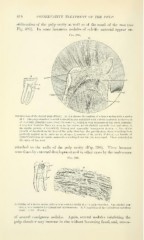Page 420 - My FlipBook
P. 420
418 CONSERVATIVE TREATMENT OF THE PULP.
obliteration of tlie ])ulp cavity as well as of the canal of the root (see
Fig. 395). In some instances nodnles of calcific material appear nn-
FiG. 39o.
Calcification of the dental pulp (Black). At A is shown the outline of a lower molar with a cavity
at b. The pulp chamber is much reduced iu size and filled with calcific material, as shown in
B. a, a large granular mass of calcific material, which is very transparent but finely granular.
A very few irregular lines are seen in the centre, which slightly resemble dentinal tubes
; 6,
an erratic growth of irregularly formed and unusually transparent dentin
; c, line of the
growth of dentin from the floor of the pulp chamber : the growth from other directions is so
perfectly regular as to leave no markings; d, margin of the cavity of decay; c, a bundle of
cylindrical forms of calcific material extending down into the root canal. These extended to
the apex of the root.
attached to the walls of the pnlp cavity (Fig. .396). These increase
sometimes by external development and in other cases by the coalescence
Fig. 396.
A
A, Outline of a lower molar, with a large carious cavity at o; b, pulp chamber. The shaded por-
tion, c, was occupied by cylindrical calcifications. B, Illustration of the cylindrical calcifica-
tions. X 100. (Black.)
of several contiguous nodules. Again, several nodules inhabiting the
pulp chamber may increase in size without becoming fused, and, accom-


